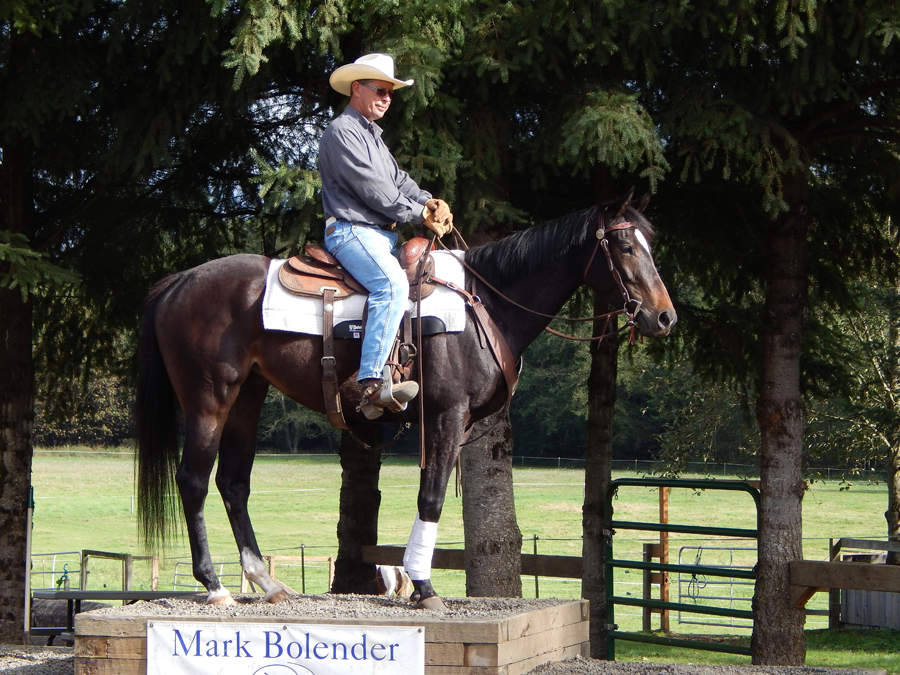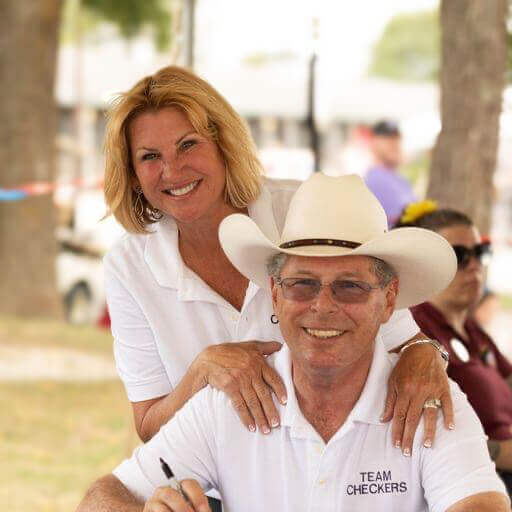Training an OTTB for the Sport of Mountain Trail
by Mark Bolender
 Off the Track Thoroughbreds (OTTB) are retired race horses that have been given a new purpose in life. Recently, I had the good fortune to train one named Dakota for mountain trail riding.
Off the Track Thoroughbreds (OTTB) are retired race horses that have been given a new purpose in life. Recently, I had the good fortune to train one named Dakota for mountain trail riding.
As it turns out, that inner vitality OTTBs draw upon for racing also gives them qualities that are well suited for mountain trail work. This new competitive sport—also called “trail challenge”—requires unique training to bring out the animal’s inner confidence in order to navigate difficult trail obstacles. In this regard, OTTBs are like an expensive computer that is pre-loaded with the necessary brain software to approach the trail with a definite boldness.
I arrived at Emerald Downs in Auburn, WA to pick up Dakota, a lean, black mare owned by the Wilmont family. The Wilmonts are dedicated to OTTBs and with the help of the Prodigious Fund have been giving these beautiful animals new life and purpose. I’m indebted to them for giving me the opportunity to experience the majesty of Dakota.

From the start I knew this was going to be a unique experience. Dakota pranced lightly from her stall to the trailer. I could tell her mind was willing and happy and that she wouldn’t have a problem moving forward, a necessity of mountain trail training. Once at Bolender Horse Park, Dakota absorbed her surroundings with enthusiasm. To begin her training, I started with basic mind exercises. Dakota demonstrated a brilliant mind and was willing to work. When she was introduced to the obstacles she quickly put her head down to “hunt the trail.” Our progress on the first day was spectacular and in the days that followed on the trail course she proved to be one of the fastest learners I’ve ever had.
With the ground work done, it was time to ride. Dakota took the western saddle and tack without issue, and she accepted the fact that it was time to learn again with the same eagerness to work. Dakota – and I believe all OTTBs – have an interesting trait. It’s usually a challenge to motivate the horse to move forward in an obstacle field, but Dakota moved forward much faster than I expected. I even reflexively held her back somewhat.
Since race horses are trained to grab the bit and take off, I realized I needed to redirect her energy instead of trying to contain it. We worked hard to build a foundation of softness at a walk and trot, as well as moving the hips and shoulders. Dakota was bred and trained to run, so I couldn’t expect her to simply turn off the voltage. I made it her choice to take it slowly in order to avoid a tug-of-war. Going slow and thinking it through is actually natural to a horse. I helped cultivate this in Dakota and she applied herself beautifully, taking time to think about each step. This is crucial to a good mountain trail horse. I then took her to the arena to begin working on getting a soft and relaxed walk and trot. Picking up the canter was a little more difficult due to Dakota’s former career. Even with this amazing energy she was like riding a feather; I wasn’t sure her feet were ever touching the ground.

Dakota had little knowledge of what my leg was telling her to do and maintaining a small circle was nearly impossible. So we backed up and started again at the walk and trot with many transitions, changes of direction, and leg yields. It seemed like baby steps at first, but Dakota learned quickly and was willing. Very soon she found her peace in loping slowly and relaxed, without being forced. This was the breakthrough that I had been waiting for. At that point I asked her to trot over some poles. Then we went back out to the mountain trail course to finish her training where she was completely relaxed.
Training Dakota has been so enjoyable because she’s energetic, bright, and willing to work at any task you give her. She never bucked and took discipline and instruction beautifully. Through this I learned that training an OTTB takes a little more effort tailored to their special experiences, but the rewards are amazing. I’m completely certain these beautiful horses can accomplish any task they’re presented with, including the new discipline of mountain trail and extreme trail. I strongly encourage everyone to give these horses the new life they deserve. With proper training they’ll find a place in your heart forever, as Dakota has with everyone at Bolender Horse Park.
For information on training, shows, and clinics from nationally recognized trainer and three-time extreme trail champion Mark Bolender visit bolenderhorsepark.com.
Published in November 2013 Issue

Mark and Lee Bolender own and operate Bolender Horse Park in Washington State, which houses the finest Mountain Trail course in the world. They are the founders of the International Mountain Trail Challenge Association (IMTCA) and travel worldwide as clinicians and ambassadors of Mountain Trail. Bolender Horse Park offers riders of all skill levels and disciplines a fun and challenging trail riding adventure.
Mark has designed and built Mountain Trail courses in the USA, Canada, Australia, and Europe—with many more in development. Mark uses his artistic, landscaping, horse training, and construction skills to build these courses (NW Steel Design LLC www.nwsteeldesign.com).
Mark is the author of Bolender’s Guide to Mastering Mountain and Extreme Trail Riding. Visit www.bolenderhorsepark.com to learn more.





